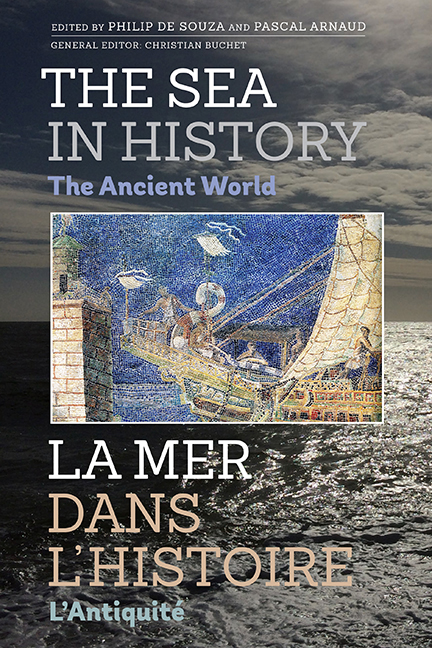Book contents
- Frontmatter
- Contents
- List of Illustrations
- List of Contributors
- Introduction générale et remerciements par Christian Buchet
- General introduction and acknowledgements
- Introduction (français)
- Introduction (English)
- La mer est le propre d'Homo sapiens
- PREHISTORICAL CASE STUDIES
- Maritime aspects of early Andean civilizations
- Une approche maritime et archipélique de l'occupation amérindienne des Antilles
- The Taíno of the Caribbean: six thousand years of seafaring and cultural development
- The importance of the sea for prehistoric societies in Western Europe
- Pêche et interactions entre la Moyenne Vallée du fleuve Sénégal et le littoral atlantique Sénégalo-Mauritanien durant le dernier millénaire BC
- The sea and early societies in the Japanese Islands
- Développement maritime de la civilisation océanienne
- HISTORIAL CASE STUDIES: The Ancient Near East and Pharaonic Egypt
- HISTORICAL CASE STUDIES: The Mediterranean world
- HISTORICAL CASE STUDIES: The Indian Ocean and the Far East
- Conclusion (français)
- Conclusion (English)
- Conclusion générale par Christian Buchet
- General conclusion
- Comprendre le rôle de la mer dans L'histoire pour éclairer notre avenir
- Understanding the role the sea has played in our past in order to shed light on our future!
The importance of the sea for prehistoric societies in Western Europe
from PREHISTORICAL CASE STUDIES
Published online by Cambridge University Press: 20 April 2017
- Frontmatter
- Contents
- List of Illustrations
- List of Contributors
- Introduction générale et remerciements par Christian Buchet
- General introduction and acknowledgements
- Introduction (français)
- Introduction (English)
- La mer est le propre d'Homo sapiens
- PREHISTORICAL CASE STUDIES
- Maritime aspects of early Andean civilizations
- Une approche maritime et archipélique de l'occupation amérindienne des Antilles
- The Taíno of the Caribbean: six thousand years of seafaring and cultural development
- The importance of the sea for prehistoric societies in Western Europe
- Pêche et interactions entre la Moyenne Vallée du fleuve Sénégal et le littoral atlantique Sénégalo-Mauritanien durant le dernier millénaire BC
- The sea and early societies in the Japanese Islands
- Développement maritime de la civilisation océanienne
- HISTORIAL CASE STUDIES: The Ancient Near East and Pharaonic Egypt
- HISTORICAL CASE STUDIES: The Mediterranean world
- HISTORICAL CASE STUDIES: The Indian Ocean and the Far East
- Conclusion (français)
- Conclusion (English)
- Conclusion générale par Christian Buchet
- General conclusion
- Comprendre le rôle de la mer dans L'histoire pour éclairer notre avenir
- Understanding the role the sea has played in our past in order to shed light on our future!
Summary
ABSTRACT.This contribution shows how the sea was an essential vector for the spread of material culture, technologies, ideas and belief systems amongst the communities of the Atlantic seaboard of Europe from Neolithic times. It argues that, as early as the fourth millennium BC, communities were connected by the sea over great distances, and it concludes with the suggestion that maritime enterprises stimulated and facilitated the development of Celtic as a common language amongst the peoples of these regions.
RÉSUMÉ.Cette contribution explique de quelle manière la mer fut un vecteur essentiel à la diffusion de la culture matérielle, des technologies, des idées et des systèmes de croyance parmi les communautés de la côte atlantique européenne au Néolithique. En arguant de la connexion par voie de mer de communautés même très distancées dès le IVème millénaire av. J.-C., elle conclut en suggérant comment les activités maritimes ont pu stimuler et faciliter la propagation du Celte comme langue commune parmi les peuples de ces régions.
The communities of Europe who face the Atlantic Ocean are unusually privileged, since they command a rich, varied and vibrant environment. The Gulf Stream which flows in a great arc from the Caribbean northwards across the Atlantic and then southwards down the European façade brings warm, nutrient-rich water, the quality of which is further enhanced by the sediment churned up over the shallow continental shelf and by additional silts brought down by the great rivers. Together these factors combine to create a rich environment for the growth of plankton which sustains the fish, crustaceans and molluscs and mammals living higher up the food chain. The turbulent Atlantic coastal seas are abundant with a great variety of wild life contrasting dramatically with the sluggish, species-poor Mediterranean.
At its most extensive the Atlantic façade confronts the ocean from about 25°N to almost the Arctic Circle – from Morocco to Iceland. Over such a distance there is much temperature variation favouring differing maritime faunas, from tuna off the Moroccan shores to the famous shoals of cod in the waters around Iceland and Greenland. Communities would have learned to specialize their gathering activities according to what nature had to offer.
- Type
- Chapter
- Information
- The Sea in History - The Ancient World , pp. 78 - 88Publisher: Boydell & BrewerPrint publication year: 2017

